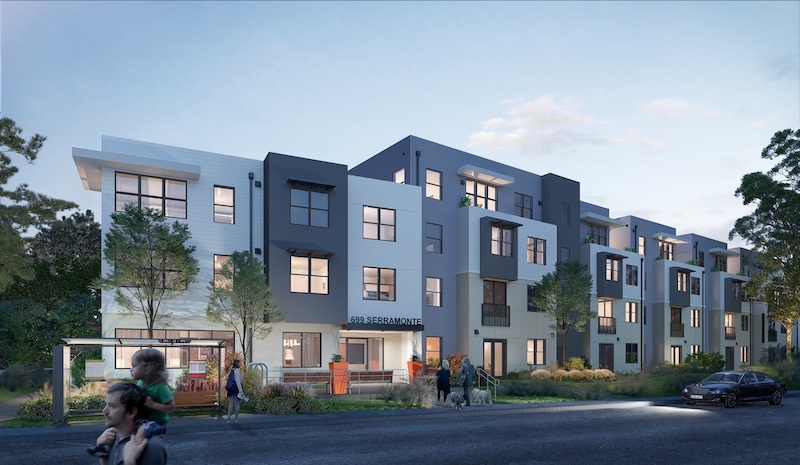The affordable housing shortage in the U.S. is particularly acute in California, where less than one-third of the state’s households can afford a median-priced home that now tops $600,000, or more than twice the national average.
School districts in California’s priciest regions have had trouble attracting and holding onto K-12 teachers whose midrange annual salaries, statewide, are from $67,032 to $87,373 for high school districts; $65,210 to $81,840 for elementary school districts; and from $63,243 to $74,676 for Unified School Districts, according to the California Department of Education.
An analysis last year by EdSource found that in 47 Bay Area school districts, even the highest-paid teachers could only afford a one-bedroom apartment.
To address this need, several of the state’s counties and school districts—including those in Santa Clara, San Francisco, Sonoma County, West Contra Costa, and Mountain View—have either approved the construction of affordable housing for teachers and staff, or are considered it.
One of these districts is Jefferson Union High School in Daly City, where in June 2018 voters approved Measure J, a $33 million general obligation bond to help pay for the construction of affordable apartments for teachers and staff, a first for this state.
This $61 million Serramonte Faculty and Staff Housing project for Jefferson Union High School District broke ground on February 5, and its first units are scheduled to available in the spring of 2022. The facility will consist of 122 apartments, with 59 one-bedroom, 55 two-bedroom, and eight three-bedroom units. The homes will range from 640 to 1,270 sf. Most important, the units’ rent rates will be 50% of market rates at the time occupancy.
J.H. Fitzmaurice, a general contractor based in Emeryville, Calif., is the GC on this project, which SVA Architects designed. The school district, comprised of five schools and a Youth Health Center, has just under 4,900 students, according to the latest data.
A September 2017 survey of the district’s employees (48.5% of whom were tenured teachers), found that 25% of 266 respondents said they were “very interested” in employee housing, 14% were “somewhat interested,” and 24% “would consider” leasing. At the time of the survey, 41.2% of 262 respondents said they owned their homes.
Nearly one-quarter of total respondents were paying between $2,000 and $2,499 per month in rent or mortgage, 13.2% were paying $2,500 to $3,000, and 12.8% were paying more than $3,000. That translated to 29.7% of respondents who were spending 31% to 40% of their household monthly incomes for rent or mortgage, 17.7% paying between 41% and 50% of their incomes, and 13.5% paying more than 50%.
Related Stories
| Nov 7, 2014
Prefab helps Valparaiso student residence project meet an ambitious deadline
Few colleges or universities have embraced prefabrication more wholeheartedly than Valparaiso (Ind.) University. The Lutheran-based institution completed a $27 million residence hall this past summer in which the structural elements were all precast.
| Nov 3, 2014
Novel 'self-climbing' elevator operates during construction of high-rise buildings
The JumpLift system from KONE uses a mobile machine room that moves upward as the construction progresses, speeding construction of tall towers.
| Nov 3, 2014
Cairo's ultra-green mixed-use development will be topped with flowing solar canopy
The solar canopy will shade green rooftop terraces and sky villas atop the nine-story structure.
| Oct 31, 2014
Dubai plans world’s next tallest towers
Emaar Properties has unveiled plans for a new project containing two towers that will top the charts in height, making them the world’s tallest towers once completed.
| Oct 29, 2014
Better guidance for appraising green buildings is steadily emerging
The Appraisal Foundation is striving to improve appraisers’ understanding of green valuation.
| Oct 27, 2014
Studio Gang Architects designs residential tower with exoskeleton-like exterior for Miami
Jeanne Gang's design reinvents the Florida room with shaded, asymmetrical balconies.
| Oct 21, 2014
Passive House concept gains momentum in apartment design
Passive House, an ultra-efficient building standard that originated in Germany, has been used for single-family homes since its inception in 1990. Only recently has the concept made its way into the U.S. commercial buildings market.
| Oct 21, 2014
Perkins Eastman white paper explores state of the senior living industry in the Carolinas
Among the experts interviewed for the white paper, there was a general consensus that the model for continuing-care retirement communities is changing, driven by both the changing consumers and more prevalent global interest on the effects of aging.
| Oct 16, 2014
Perkins+Will white paper examines alternatives to flame retardant building materials
The white paper includes a list of 193 flame retardants, including 29 discovered in building and household products, 50 found in the indoor environment, and 33 in human blood, milk, and tissues.
| Oct 15, 2014
Harvard launches ‘design-centric’ center for green buildings and cities
The impetus behind Harvard's Center for Green Buildings and Cities is what the design school’s dean, Mohsen Mostafavi, describes as a “rapidly urbanizing global economy,” in which cities are building new structures “on a massive scale.”
















